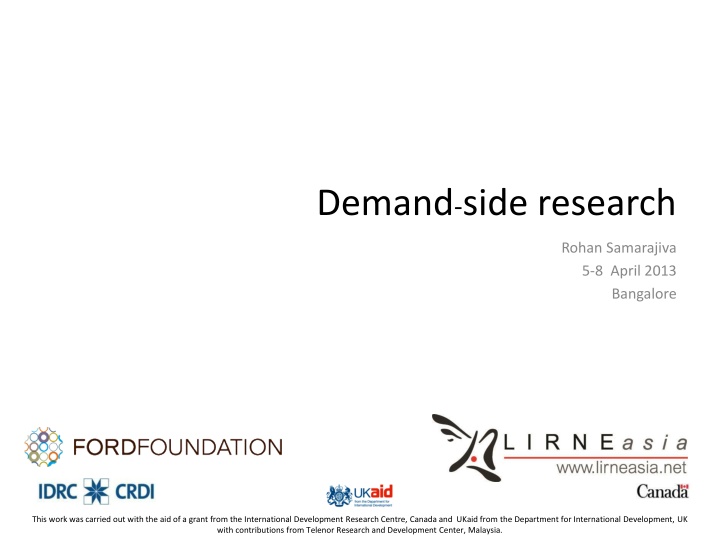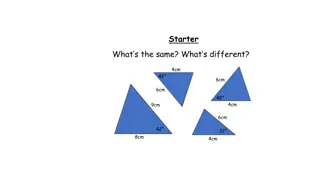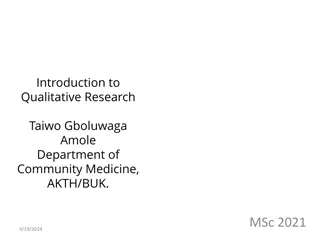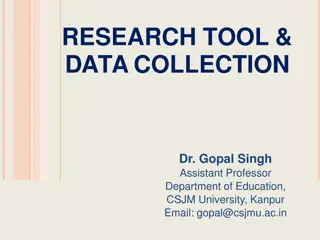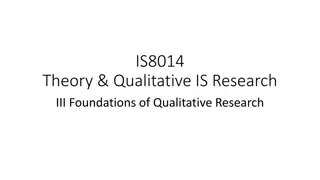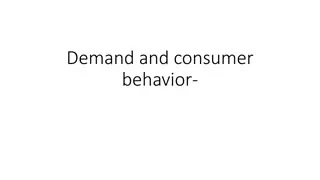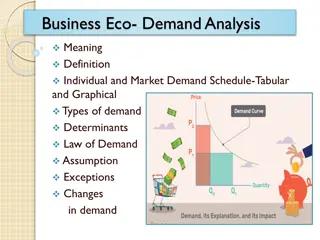Demand-side Research: Quantitative vs Qualitative Approaches
This work conducted in Bangalore in April 2013 explores the differences between quantitative and qualitative research methods, highlighting their characteristics, data collection techniques, and purposes. The combination of both approaches is considered ideal, with timing being crucial for effective outcomes. The Teleuse@BOP initiative examines ICT usage at the base of the pyramid in emerging Asian countries through large-scale surveys and face-to-face interviews since 2005.
Download Presentation

Please find below an Image/Link to download the presentation.
The content on the website is provided AS IS for your information and personal use only. It may not be sold, licensed, or shared on other websites without obtaining consent from the author.If you encounter any issues during the download, it is possible that the publisher has removed the file from their server.
You are allowed to download the files provided on this website for personal or commercial use, subject to the condition that they are used lawfully. All files are the property of their respective owners.
The content on the website is provided AS IS for your information and personal use only. It may not be sold, licensed, or shared on other websites without obtaining consent from the author.
E N D
Presentation Transcript
Demand-side research Rohan Samarajiva 5-8 April 2013 Bangalore This work was carried out with the aid of a grant from the International Development Research Centre, Canada and UKaid from the Department for International Development, UK with contributions from Telenor Research and Development Center, Malaysia.
QUANTITATIVE VS QUALITATIVE APPROACHES
Quantitative methods Qualitative methods Information represented as numerical data, use of statistical methods to estimate population parameters Non-numerical data that is observed (verbal as well as non-verbal responses/ reactions) Not necessarily in-depth In-depth understanding of human behaviour Primary data collection (surveys) ; secondary data collection (S-side analysis) Focus group discussions, key informant interviews, ethnographic story-telling, content analysis Multiple sampling techniques Purposeful sampling More generalizable Less generalizable More objective: provides observed effects (interpreted by researchers) More subjective: describes a problem or condition from the point of view of those experiencing it Deductive process to test pre-specified concepts, constructs, hypotheses that make up a theory Can also be an inductive process to formulate a theory
Quantitative or qualitative? Combination is ideal; timing is crucial E.g. multiple SIM ownership question Bangladesh Pakistan India Sri Lanka Philippines Thailand 2008 2006 2008 2006 2008 2006 2008 2006 2008 2006 2008 More than 1 SIM 10% 12% 23% 5% 9% 9% 16% 9% 19% 1% 13% Qualitative told us Why How policy implications? Final outcome depends on your objectives and resources
Introduction to QUANTITATIVE APPROACHES
Teleuse@BOP tries to understand ICT use at the BOP in emerging Asia Large surveys of BOP conducted in 2005, 2006, 2008, (2011) Almost 20,000 face to face interviews in 6 countries since 2005 Bangladesh (2008) Pakistan India Sri Lanka Philippines Thailand
Basic steps Research design Questionnaire design Data collection and processing Sampling Data analysis Research Objectives Conceptual Framework Hypothesis Formulation Selection of research method Mode of survey Identify Target group Indentify sampling technique Principles of questionnaires Improvement s to questionnaire Pilot testing the questionnaire Training the enumerator Quality check Data entry Data cleaning Descriptive Statistics Inferential statistics
Mode of survey depends on research objectives, among other factors Cost Response rate Researcher bias Potential misinterpret ation Low Anonymity/ privacy burden on respondent High Very high High None Low F2F Medium High Medium Low Low Low Phone Low Low None High High High Mail Very Low Low None High High Medium Online Other options such as computer-assisted telephone interviews & computer-assisted personal interviews LIRNEasia used (quantitative) diary approach to explore call patterns at the BOP
Hypothesis: women use the phone more for social purposes than men Use patterns Phone bills? Questionnaire? Capture at point of usage? diary
Sample: a representative part of an entire group or population population sample Population: who you want to make inferences about E.g., SEC D and E telephone users aged 15-60
Sample selection method is key for representation Idea is to estimate characteristics of population (parameters) as accurately as possible based on characteristics of sample (statistics) Without a representative sample a survey will produce results that are biased and misleading
Sampling Techniques Random Simple random sampling Stratified random sampling ... Non-random Purposive sampling Convenience sampling
Random sampling Every member in the population must have a known opportunity of being selected The selection of any member of the population must have no influence on the selection of any other member Random sampling always produces the smallest possible sampling error Sampling error in a random sample is affected only by random chance Sampling frame is needed (list of the people or items from which a statistical sample is taken)
Sample size determined by formula; increases with desired precision level n= 384 for precision level of +5% n= 1,537 for precision level of +2.5% n= 9,604 for precision level of + 1%
Simple Random Sampling Used with a homogeneous population Sampling frame is needed Random number generator (e.g., MS Excel) used to select sample
Stratified Random Sampling Used when the population is heterogeneous Ensures representation of sub-groups (strata) within the population Requires detailed knowledge of the distribution of characteristics of the population population sample
Teleuse@BOP: Multi-stage stratified sampling (with variations) 1. States / Provinces / Districts (primary sampling unit) randomly selected 2. Urban and rural centers randomly selected 3. Starting points randomly selected (# determined in proportion to population) fixed number of interviews around each starting point Every 3rd HH selected right hand rule Household members listed into Kish grid (random number chart)
Other kinds of sampling Cluster sampling Systematic sampling Combinations
Systematic Sampling Frequently done in exit polling of voters or store customers n = population size (N)/sample size needed Start with a random number between 1 and N choose every nth member in the population
Non-random methods Purposive sampling Convenience sampling Snowballing
Purposive sampling Usually would have one or more specific predefined groups The researcher chooses the sample based on who they think would be appropriate for the study Eg. T@BOP Migrant Sample was selected through purposive sampling and to some degree snow-ball sampling
Convenience Sampling Sample drawn from a population close at hand Ex: First 10 people you meet Sample may not be representative
Simple kinds of data analysis ICT use and ownership (% of BOP) Use a mobile Own a mobile Use the Internet Own a computer 95 90 76 74 69 59 * 52 50 41 37 34 32 * 18 16 12 4 3 3 2 1 1 1 1 0 Bangladesh Pakistan India Sri Lanka Philippines Thailand Among BOP * Excludes CDMA fixed wireless phones in Sri Lanka
More complex Table 7: Logistic regression output for Model 1 (predicting probability of mobile Internet-only use) Coefficient Odds Ratio Significance Age squared -0.01 0.99 0.00 Ln (monthly personal income) 0.50 1.64 0.00 Gender -0.26 0.77 0.04 Walk time to nearest town -0.03 0.97 0.09 % of phone-owning contacts 1.18 3.26 0.00 Mobile ownership 0.43 1.53 0.02 Secondary education 1.23 3.41 0.00 Tertiary education 2.36 10.59 0.00 Philippines 1.65 5.21 0.00 Thailand 1.93 6.90 0.00 Constant n = 483; Nagelkerke R Square: 0.429 -6.34 0.00 0.00
Introduction to QUALITATIVE METHODS
Qualitative research In-depth and detailed Helps understand a research problem from the perspective of the affected local population It s never just about what they say, but also what they do Visual cues as important as verbal cues Effective in getting culturally specific information about particular populations: Values, opinions, attitudes, behaviors and social contexts 29
When is qualitative research appropriate? When the hypothesis is not yet fully formed E.g. why women in some villages use their phones less when their children are around.? Could be a precursor to a quantitative study. Could be a considered exploratory research When one wants to know why a certain phenomenon occurs E.g. Why do people in the ages 10-16 use their phones more when they are at home and you want to know why? Could be that the phenomena was discovered during a previous quantitative study. Could be considered as explanatory research When a descriptive answer is needed E.g. What are the attitudes of users to having a off-peak time start at 7pm. 30
Different kinds of qualitative research Case studies Focus groups Unstructured interviews Diary/ Journal method Ethnographic studies Field research User personas Participatory design & evaluations Photo novellas 31
Ethnographic studies Observational field work done in the actual context being studied Participant observation i.e. immersion of researcher in actual context E.g. trying to understand call behavior at work. Much heavier focus on how individuals interrelate in their own environment and the influence of this environment on individuals E.g. how long is he on the phone when his boss is around? E.g. What is his body language when talking on the phone with boss around, in front of colleagues, when no one is around, etc. 32
Ethnographic studies Pros: Richer understanding of complex social/ cultural actions Cons: Difficult to interpret and analyze Time consuming and expensive Researcher can influence behavior. 33
Focus groups Aids in understanding audience, group, users. Concentrates more on group interactions more than individual responses. Pros: Collective discussion gives more data than individual discussions Group discussions can trigger individual memories/ recall. Cons: Group think Social/ cultural issues can affect how one acts in front of a group 34
SOME EXAMPLES FROM TELEUSE@BOP3
Ronnie | Manila, Philippines 27 years | Shop helper / Barbecue vendor / e load seller Ronnie downloads ringtones as well as has ring-back tones on her phone which expire in 24 hours. So she activates them frequently. She also downloads these from the Internet at a cybercafe too. 36
Ronnie | Manila, Philippines 27 years | Shop helper / Barbecue vendor / e load seller Ronnie only uses the news feature from her service provider in order to keep updated. For all other forms of information, she either consults someone in her social circle (by phone), watching TV or going to information centers, like city hall, health center etc. 37
Zayed | Shopkeeper 21 years | Sonargaon, Bangladesh Once facilitated money transfer through mobile for the village maulavi who was away in Dhaka; the maulavi sent BDT1,000 in load to Zayed s mobile; once the load was received, Zayed then paid the same in cash to the maulavi s family in the village Transactions of up to BDT5,000 (USD70) can be made, however this is dependent upon the shopkeeper having cash available to give the intended recipient in one go Commissions can be as high as 20%; the shopkeeper commission on reselling the load also makes
